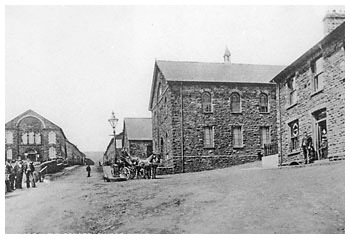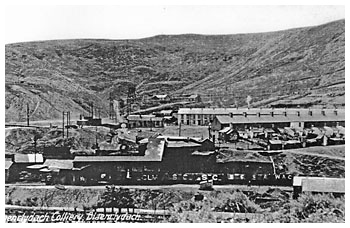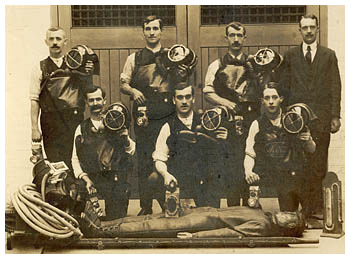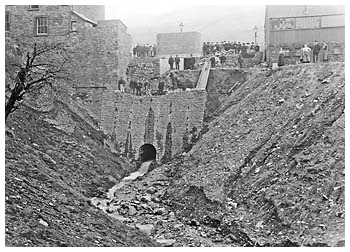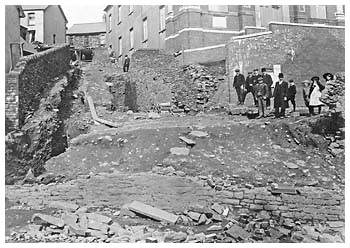
Clydach Vale |
|
Named after the River Clydach, which flows down the valley into the River Rhondda at Tonypandy, the records show that in the 17th century the valley was already known as Duffryn Clydach (Duffryn meaning Vale). The valley can be divided into two separate villages, Blaenclydach, literally the head of the Clydach, and Cwm Clydach, or Clydach Valley. |
|
The Square Clydach Vale circa 1900 |
Despite this early industrial activity Clydach Vale remained a 'wooded glen' of 'great natural beauty'. However the period between 1863 and 1880, was an era of unprecedented expansion leading to Clydach Vale being one of the most populous, heavily built up areas, not just in the Rhondda, but in the whole of Wales. This expansion began when Bush and Company opened Lefel-Y-Bush to the No.2 Rhondda Seam, and when in 1863 Blaenclydach Colliery was opened to the No.3 Rhondda seam. Additionally in January 1864 Daniel and Edmund Thomas acquired the mineral rights of the Blaenclydach Estate and Ffynondwyn Farm and opened the Cwmclydach Colliery. Also Samuel Thomas and Osborne Riches sank the Clydach Vale Collieries Nos. 1,2 and 3 over a twenty-year period starting in 1872, and by 1879 the two Clydach Vale Collieries were producing over 100 tons of coal per day |
| Clydach Vale has been a traditionally close-knit community and also a politically active one. Setting up within its confines the first permanent organisation of Rhondda miners, the Cambrian Miners' Association, a number of members of which joined the International Brigade to fight in the Spanish Civil War. It also formed 'The Clydach Vale and Blaenclydach Recreation Ground Committee' in 1921, which later became the 'Cambrian Welfare Association'. This committee was set up with a £57,000 grant and its early priorities were a children's playground, a football field, tennis courts, and bowling green. Over its sixty-plus years of existence it became the focal point of community life in the Clydach area, building and running halls, institutions and public recreation grounds. Until financial considerations meant that it had to bequeath the running of its facilities to the Rhondda Borough Council in 1977. It is a little know fact that the boxer Tommy Farr was born in Clydach Vale. | |
Clydach Vale Coal Industry |
|
Blaenclydach Collieries |
|
Blaenclydach Collieries |
The levels at Blaenclydach were first opened up in 1863 by Frank James to work the Rhondda no.3 seam, an excellent source of coking coal. Subsequently in 1875 Bush and Company opened the Blaenclydach Colliery. In 1878 the Forest Iron and Steel Company Ltd. purchased the colliery in order to supply coke for their Pontypridd furnaces, which essential in the manufacture of Haemetite and pig iron. The Blaenclydach Colliery Company also opened up the old abandoned Cwm Clydach Colliery in 1912. By 1913 over 720 men were employed at this new colliery, which became known locally as the Gorki drift mine, whilst the old colliery now known as Brookvale employed only twenty men. The Rhondda Coal Company bought the whole complex in 1920 and Powell Duffryn subsequently purchased it in 1940. It remained under their control until Nationalisation in 1947, at which time it was closed, with the loss of 41 jobs. |
Cambrian Collieries |
|
No.1 pit was sank in 1872 by a company formed by Samuel Thomas and Osborne Riches, and struck the Rhondda Six Feet seam at a depth of 400 yards in 1874. Following this success they subsequently sank the No.2 pit in 1874 and the No.3 by June 1891. Output between 1890 and 1894 averaged 700 tons daily. By this time the mine was directly served by the Taff Vale Railway and had a sidings capacity of over 840 wagons, making it a massive concern. Following the death of Samuel Thomas in 1879 his sons became managing partners and in 1895 formed the company known as Cambrian Collieries Limited Right: Cambrian Collieries circa 1900 |
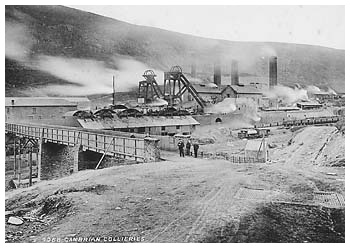 |
Cambrian Collieries Rescue Brigade 1916 |
After the Cambrian Colliery dispute of 1910, which led to the infamous Tonypandy Riots, the manpower of the colliery rose to its zenith of 4,113 in 1913. The company merged in 1929 to form Welsh Associated Collieries Limited, which merged with Powel Duffryn in 1935 to form Powell Duffryn Associated Collieries Limited. In 1934 the Colliery employed 1,900 men underground working the Pentre Two Feet Nine Seam, the Bute, yard, Five-Feet and Lower Five Feet Seams. The No.3 pit was closed in 1936. The colliery continued to be worked post Nationalisation, with 1,711 working underground in 1954. The National Coal Board finally closed the collieries in 1966. |
The Cambrian Combine |
|
| This was the first of the large mining combines formed in South Wales, and heralded a major change in the way the mining industry operated. Previously mines tended to be small, by later standards, operations run by individual colliery companies. The formation of Combines led to much bigger enterprises consisting of large number of pits working together to form what was in effect one large corporation. David Alfred Thomas, later Viscount Rhondda, advocated the formation of combines to 'control and regulate the steam coal trade of South Wales'. After attending Cambridge University he was sent to his fathers Cambrian Colliery to make a detailed study of the economic organisation of the coal industry in the Rhondda. He ascertained that, 'if it were possible to get the twenty companies or collieries constituting eighty percent of the output of South Wales to combine, the combination would... be sufficient to control and regulate the steam coal trade in South Wales and Monmouthshire'. However the fierce competition amongst the other coal owners was too intense to allow for any co-operative scheme between them. Frustrated by this opposition to his proposals, drafted in 1896, Thomas left the industry and entered Parliament. Ten years later frustrated by not attaining office in the newly elected Campbell Bannerman liberal government he returned to the Rhondda and Cambrian Colliery. Realising that opposition from other coal owners would still block his dreams of forming a combination of pits he decided to go it alone, without their assistance. This he did by a process of acquiring controlling interest in the properties of a number of rival companies, namely The Glamorgan Coal Company, The Naval Company Limited and the Brittanic Merthyr Coal Company Limited amongst others. He formed the Cambrian Trust Ltd. in 1907 and Consolidated Cambrian Limited in 1916. This became the most important amalgamation in the coal industry in the Rhondda prior to the First World War. By 1916, although falling short of his 1896 proposals, the Cambrian Combine was an industrial giant of its day with an output of over seven million tons, and producing two thirds of all the coal that was mined in the Rhondda. In addition to collieries within the Rhondda, the Combine also acquired controlling interest in a number of collieries outside the Valley in addition to other enterprises directly associated with its coal interests e.g. railways, shipping companies etc. Thus the power and size of the Cambrian Combine at the time of the Cambrian Combine Dispute (which became known as The Tonypandy Riots) in 1910 was second to none within the world of the coal industry in South Wales. |
|
| The Cambrian Colliery Disaster 1905 | |
| On the 10th March 1905 an explosion occurred at the Cambrian Collieries No.1 pit 6ft. Seam which led to the loss of life of 32 men underground, and one who died later in hospital, and serious injury to 14 others. Headlines in the local paper of Saturday March 18th exclaimed, ' Terrible explosion at Clydach Vale... Heavy Death Roll... Men still missing...Pit a veritable inferno.... Men still missing.' Upon hearing the explosion, which resounded around the valley, thousands of locals gathered at the pit top, both to offer assistance in the rescue efforts and also to discover the fate of loved ones working below. Indeed the local MP, D.A.Thomas, upon hearing of the disaster travelled by night train from London to the scene of the disaster, where he arrived at 3A.M. on the Saturday morning. At the pithead a relief gang was immediately formed consisting of Leonard Llewellyn, agent of the collieries, D Davies and Trevor Price (managers), Morris Williams (Head mechanic), and others. All of who were subsequently recognised by the Royal Humane Society for their bravery in the rescue effort. Upon descending the pit via the No.2 shaft and the Coronation Seam, 120 yards below the affected seam, they discovered 50 men alive and virtually uninjured whom they sent up to the surface. When they worked their way up to the 6ft. seam they found 13 men alive but all seriously injured, suffering from severe burns. From here however the rescue effort was stalled due to the 'intensity of the conflagration'. By two o'clock the following morning, when the first attempts to put out the fire underground had proved unsuccessful, Mr. Leonard Llewellyn stated' It is a matter of impossibility for any creature to be alive in the workings beyond the fire'. In fact it was not until the following Wednesday that the fire was finally extinguished and the falls of rock cleared to allow access to the source of the explosion. During this time 30 bodies were recovered, two of the victims' bodies were completely consumed by the ferocity of the fire. The first six funerals of the victims of the disaster were held on the Wednesday following the explosion, the six processions meeting at Clydach Square to form one cortege to the cemetery. Hundreds of people lined the streets of Clydach, all local shops closed for the afternoon and all the houses had their blinds drawn, as a mark of respect to the dead. In May 1905 a Home Office Report, by F.A.Gray one of His Majesty's Inspectors of Mines, into the cause of the explosion was published. This concluded that the explosion originated in the safety lamp of David Enoch, who died in the blast. However what actually caused the lamp to ignite was uncertain. One theory was that a rock had fallen striking and breaking the glass of the lamp, exposing the flame of the lamp and thus igniting the surrounding gas. The other theory, which the Inspector subscribed to, was that gas had exploded in the lamp forcing the gauze out and thus igniting the surrounding gas. The Cambrian explosion of 1905 was a terrible tragedy, but it could have been much worse had it not been for the timing of the explosion. The explosion occurred at 6.25 p.m. a time when the days shift had left the mine and the night shift had yet to descend. If not for this fortuitous timing of the explosion the death toll would have been far, far greater. A list of those killed can be found here. |
|
The Cambrian Colliery Disaster 1965 |
|
| 'Another sad scar in the Rhondda's History', '31 Died in Pit Hell', 'Rhondda Hell'. So read the newspaper headlines on the 18th May 1965 following an explosion at Cambrian Colliery, Clydach Vale, on Monday May 17th. The explosion occurred at just before 1.00p.m. in the Pentre Seam of the p.26 district which had only been in full production for four months, and was the last of the major colliery disasters to hit South Wales, A major rescue operation was immediately launched, at times involving over 150 men. Ten hours after the explosion the last of the bodies was removed from the two and a half feet seam 300 yards underground and more than one and a half miles from the pithead. The final toll of the explosion was 31 dead, many of whom had to be identified either from the numbers on their lamps or by their fingerprints, and 13 injured. An inquiry was held into the disaster at the Law Courts, Cardiff, over four days in the July of the year, with 58 persons appearing to give evidence. The inquiry found that the explosion was of firedamp with flame spreading along approximately 325 yards of face and return roadway. The firedamp had assumed explosive proportions due to poor ventilation circulating the district caused principally, the inquiry found, through a poorly constructed airbridge allowing the build up of gas. This gas was ignited by an electric arc on an open switch panel on which electricians were working. Therefore the explosion was deemed to be the result of poor 'pit practice'. Although used to mining disasters, this explosion shocked the nation with D. Francis stating in 'The Miner' journal, 'I never thought that in 1965 we should be faced with a tragedy such as this'. Disasters on this scale were thought to be a thing of the past. The funerals of the dead miners were held on the Friday and Saturday and were incredibly moving, more than 20,000 people silently lined the route of the funeral procession, which stretched for over two miles. The Queen herself sent a message of sympathy to the families of the injured and bereaved and a disaster fund was set up which raised over £123,000. Two years after the disaster the mine was finally closed, and in 1992 Neil Kinnock opened a Memorial garden on the site of the old pit. A list of those killed can be found here. |
|
The Clydach Vale Flood Disaster |
|
A scene from the flood disaster |
Five years, almost to the day, after the Cambrian explosion of 1905 another disaster befell the village of Clydach Vale. Although this disaster did not happen underground, it was directly attributable to the legacy of mining in the area. In this case it was one of the original 'Perch' levels, which had lain abandoned for the previous five years that was found to be responsible. It had been known for some time that these abandoned levels had been accumulating a reservoir of water and a contractor had been engaged in 'tapping' the reservoir in order to drain its contents into a nearby stream. Whether this disturbing of the reservoir wall destabilised it thus bringing about the very occurrence it was intended to prevent, is a matter of conjecture. What is clear is that about 4.00 p.m. on Friday 11th March 1910 the mountainside seemed to give way, 'as though from a volcanic eruption' and a torrent of water together with huge amounts of earth, boulders and other debris swept down the hillside. |
| Directly in the path of this torrent lay Adams terrace, and according to contemporary newspaper reports the first house it encountered 'was in a moment completely wrecked like a pack of cards' and its occupants Mrs. Elizabeth Ann Williams and her four month baby girl perished. The newspaper goes on to state that, 'Altogether eleven houses and a shoemakers shop were wrecked, one being completely washed away'. The floodwaters then continued down towards the Clydach Vale School, which at that moment contained nine hundred children The headmaster of the school, Mr.R.B.Williams, looking out of a classroom window saw the flood approaching the school, and immediately set about to secure the safety of the pupils under his care. The boys and elder children of the school were led to safety, a large number having to be passed over the playground wall into a nearby lane. The speed of the torrent however meant that it was impossible to evacuate the Girls and Infants school before they became inundated. A contemporary newspaper account described the scene of children 'hurled in all directions' and 'floating around...like so many corks'. By chance the flood coincided with the end of the shift at the local mine, and luckily a large number of miners were passing the school at the time. These colliers immediately joined in the rescue efforts placing timbers and ladders against the walls of the Girls' school and helping the children to safety through the windows of the school and into the boys' playground. Similarly those trapped in the Infants' school were led thorough the windows and into the Girls' school and hence to safety. |
The force of the water in the playground finally forced the boundary wall to give way, causing the waters to flow harmlessly down the incline to join the river Rhondda. The damage caused by this flood shocked the inhabitants of Clydach vale, with thousands coming to view the scene of devastation. However if it was not for the bravery of the schools' teachers and those passers by joining in the rescue effort the death toll caused by this flood could have been much, much worse. |
| A large number of children trapped by the floodwaters in the children's playground were handed over the boundary wall and thereby rescued. Despite the best efforts of the rescuers three of the schoolchildren were drowned, Blodwen Davies, aged nine, Enid Howells Aged six and Gertrude Rees, aged five. This meant that in total the disaster had claimed a total of six lives with the deaths of Elizabeth and Francis Williams and Haydn Brimble all of Adams Street. | |
